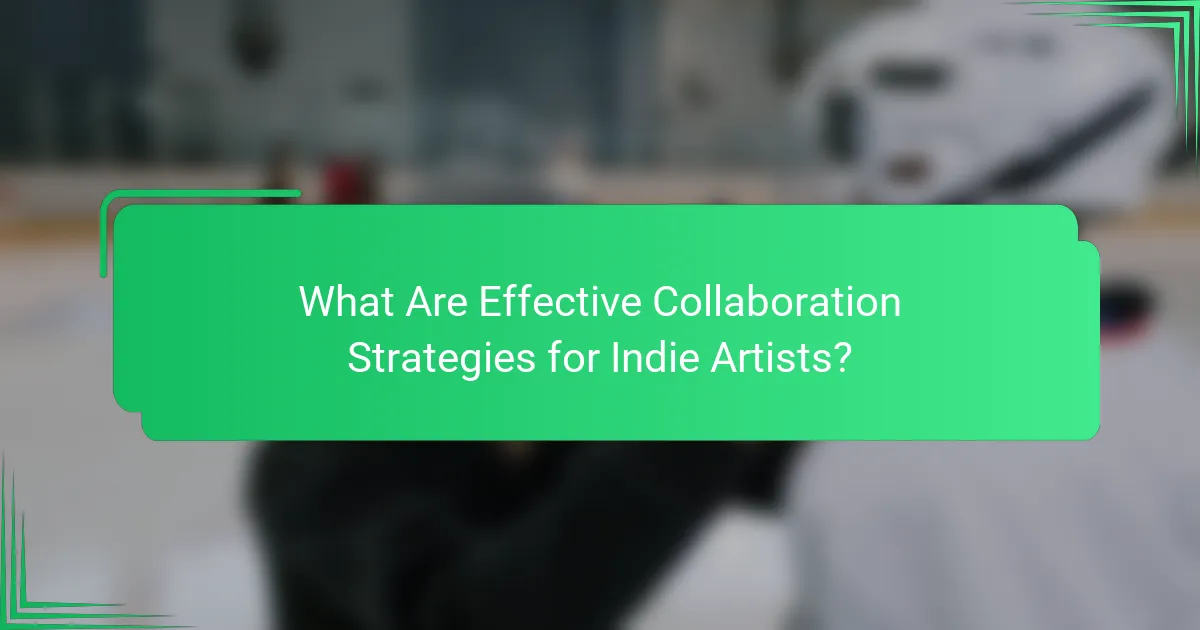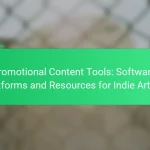Indie music campaigns can significantly benefit from joint marketing efforts, allowing artists to collaborate with others and broaden their audience. By engaging in partnerships and utilizing shared resources, these campaigns enhance visibility and foster a sense of community within the music industry. Effective strategies include networking and connecting with influential platforms, while success can be measured through metrics like streaming statistics and social media engagement.

How Can Indie Music Campaigns Leverage Joint Marketing?
Indie music campaigns can effectively leverage joint marketing by collaborating with other artists or brands to expand their reach and audience. This approach not only enhances visibility but also fosters community engagement and shared resources.
Collaborative playlists on Spotify
Creating collaborative playlists on Spotify allows indie artists to combine their music with others in a cohesive listening experience. This strategy can attract fans from different genres and increase streams for all participating artists.
To maximize impact, artists should promote these playlists on their social media and encourage fans to share them. Consider featuring a mix of popular tracks and lesser-known gems to appeal to a broader audience.
Cross-promotional social media strategies
Cross-promotional social media strategies involve artists sharing each other’s content to tap into new follower bases. This can include reposting stories, sharing posts, or even hosting joint live sessions.
For effective execution, set clear goals and timelines for promotions. Regularly engage with each other’s audiences to build a sense of community and encourage interaction.
Shared merchandise collaborations
Shared merchandise collaborations enable artists to create unique products that reflect both brands, such as limited-edition clothing or accessories. This not only generates additional revenue but also fosters a sense of exclusivity among fans.
When designing merchandise, consider combining visual elements from both artists to create appealing products. Promote these items through both artists’ channels to maximize reach and sales potential.
Joint live events and tours
Joint live events and tours allow indie artists to share the stage, attracting larger crowds and reducing individual costs. This collaboration can enhance the overall experience for fans, offering diverse performances in one setting.
When planning these events, coordinate schedules and marketing efforts to ensure a seamless experience. Consider local venues that cater to both fan bases and promote the events through all participating artists’ platforms.
Co-branded music videos
Co-branded music videos can showcase the unique styles of collaborating artists while reaching wider audiences. By combining resources, artists can produce higher-quality content that may be more visually appealing and engaging.
To create impactful co-branded videos, develop a shared concept that highlights both artists’ strengths. Promote the video across all social media channels to maximize views and engagement, encouraging fans to share their thoughts and reactions.

What Are Effective Collaboration Strategies for Indie Artists?
Effective collaboration strategies for indie artists include networking, building partnerships, and engaging with influential platforms. These approaches can enhance visibility, expand reach, and foster community within the music industry.
Networking through music festivals
Music festivals provide a prime opportunity for indie artists to network with other musicians, industry professionals, and potential fans. Attending these events allows artists to connect face-to-face, share experiences, and discuss potential collaborations.
To maximize networking at festivals, artists should prepare by researching attendees and creating a list of key contacts. Engaging in conversations, exchanging contact information, and following up after the event can lead to fruitful partnerships.
Building partnerships with local venues
Establishing partnerships with local venues is crucial for indie artists looking to perform regularly and gain a loyal audience. Collaborating with venues can involve hosting joint events, promoting each other on social media, or creating special offers for ticket sales.
Artists should approach venues with a clear proposal that highlights mutual benefits, such as increased foot traffic or shared marketing efforts. Regular performances can also help build a strong local following and enhance visibility within the community.
Engaging with music blogs and influencers
Connecting with music blogs and influencers can significantly amplify an indie artist’s reach. These platforms often have dedicated audiences that trust their recommendations, making them ideal for promoting new music or upcoming shows.
Indie artists should research relevant blogs and influencers in their genre, then reach out with personalized messages that showcase their music and explain why it would resonate with their audience. Building genuine relationships can lead to features, reviews, and social media shoutouts, enhancing overall visibility.

How to Measure the Success of Indie Music Campaigns?
Measuring the success of indie music campaigns involves evaluating various metrics that reflect audience engagement and financial performance. Key areas to focus on include streaming statistics, social media engagement, and merchandise sales.
Tracking streaming statistics
Streaming statistics provide insight into how often your music is being played across platforms like Spotify, Apple Music, and YouTube. Key metrics to track include total streams, listener demographics, and playlist placements.
Consider setting specific goals, such as achieving a certain number of streams within a month or increasing your monthly listeners by a percentage. Tools like Spotify for Artists and Apple Music for Artists can help you analyze these metrics effectively.
Analyzing social media engagement
Social media engagement is crucial for understanding how well your audience connects with your brand. Metrics to monitor include likes, shares, comments, and follower growth across platforms like Instagram, Facebook, and Twitter.
Engagement rates can vary widely, but a good benchmark is around 1-3% for most posts. Use analytics tools to identify which types of content resonate most with your audience, and adjust your strategy accordingly.
Monitoring merchandise sales
Merchandise sales are a tangible indicator of your campaign’s success and fan support. Track sales data from your online store or at live events to assess what items are popular and how they contribute to your overall revenue.
Consider offering limited edition items or bundles to boost sales. Regularly review sales trends to identify peak purchasing times and adjust your inventory and marketing strategies to capitalize on these insights.

What Tools Can Enhance Indie Music Marketing Efforts?
Indie music marketing can be significantly improved by utilizing various tools designed for promotion, audience engagement, and analytics. Key platforms and services can streamline efforts, making it easier to reach wider audiences and foster collaborations.
Use of platforms like Bandcamp
Bandcamp is a powerful platform for indie artists to sell music directly to fans while retaining a larger share of revenue compared to traditional distribution methods. Artists can create customizable pages, set their own prices, and offer exclusive content to build a loyal fanbase.
Utilizing Bandcamp’s features, such as pre-orders and merchandise sales, can enhance revenue streams. Artists should consider promoting their Bandcamp links through social media and email newsletters to drive traffic and sales.
Social media management tools
Social media management tools like Hootsuite or Buffer allow indie musicians to schedule posts, track engagement, and analyze audience interactions across multiple platforms. This can save time and ensure consistent communication with fans.
When selecting a tool, consider features like analytics, post scheduling, and platform integration. Regularly reviewing engagement metrics can help refine content strategies and improve outreach efforts.
Email marketing services
Email marketing services such as Mailchimp or Sendinblue enable indie artists to build and maintain direct communication with their audience. These platforms offer customizable templates and automation features that can enhance engagement and drive ticket sales or merchandise purchases.
To maximize effectiveness, artists should segment their email lists based on fan interests and behaviors, ensuring that content is relevant and personalized. Regular newsletters featuring updates, exclusive offers, and upcoming events can help maintain fan interest and loyalty.

What Are the Key Criteria for Selecting Collaboration Partners?
When selecting collaboration partners for indie music campaigns, it’s essential to consider factors that align with your goals and audience. Key criteria include shared audience demographics, complementary artistic styles, and mutual promotional strategies.
Shared audience demographics
Understanding shared audience demographics is crucial for effective collaboration. Look for partners whose fan bases overlap with yours in terms of age, interests, and geographic location. This alignment increases the likelihood of engagement and conversion.
For example, if your music appeals to young adults aged 18-25, consider collaborating with artists or brands that target the same age group. This can lead to more effective marketing efforts and a higher return on investment.
To assess audience demographics, utilize tools like social media analytics and streaming platform insights. These resources can provide valuable data on age, gender, and location, helping you make informed decisions about potential partners.


